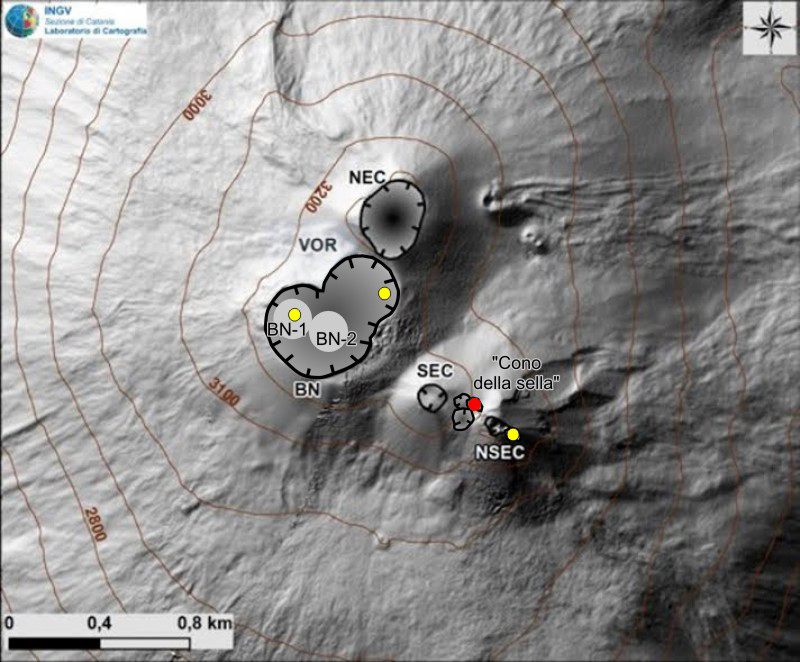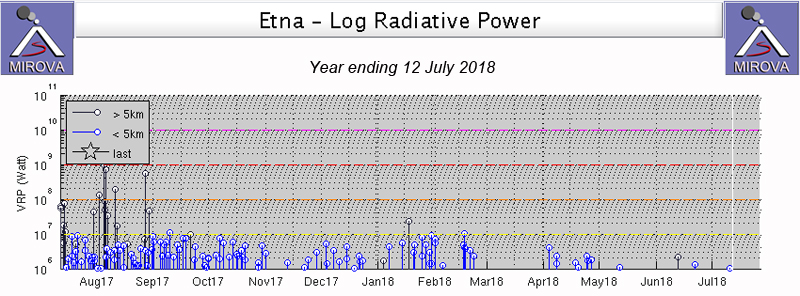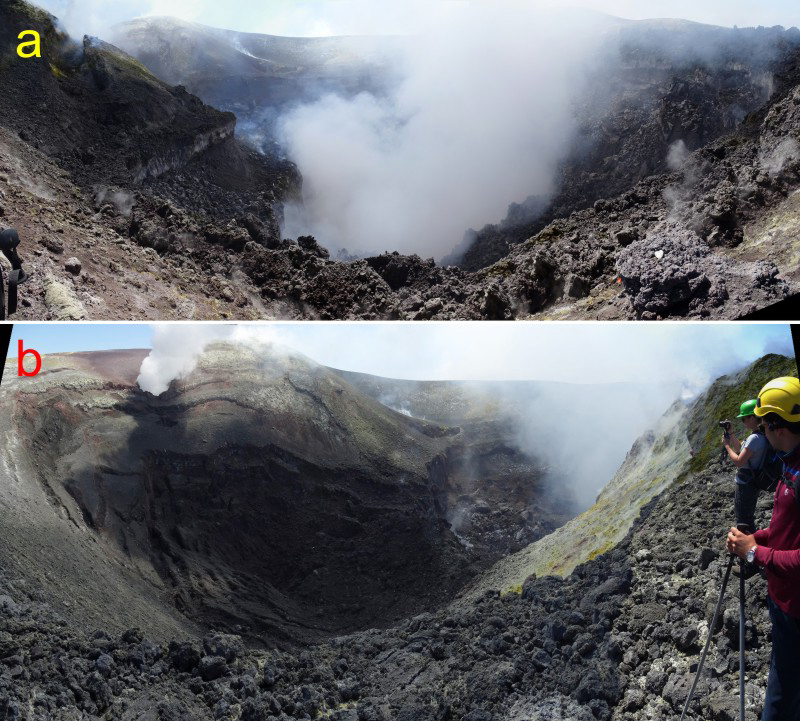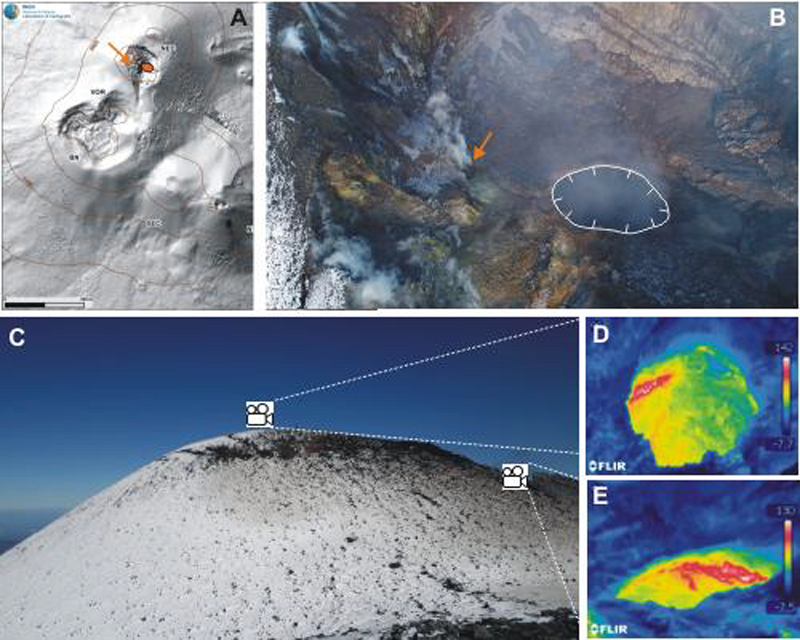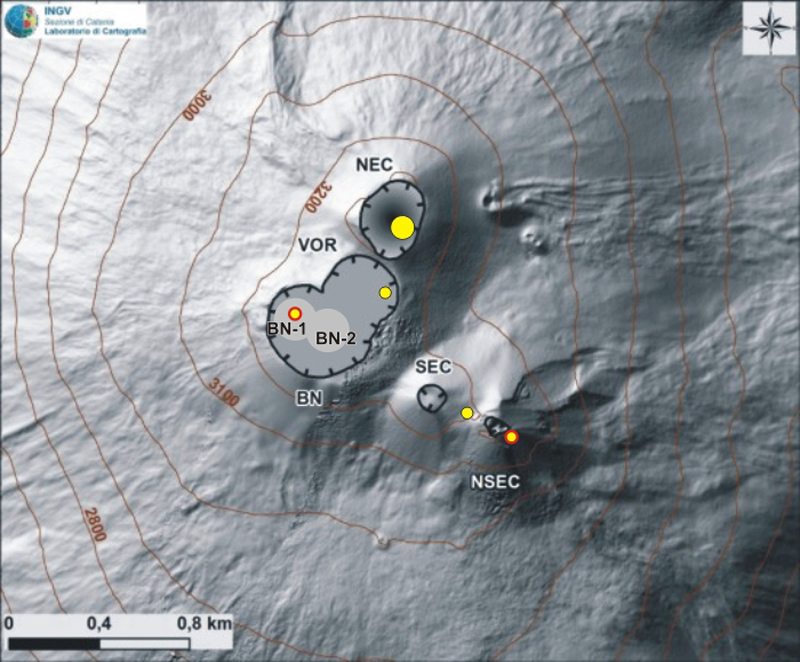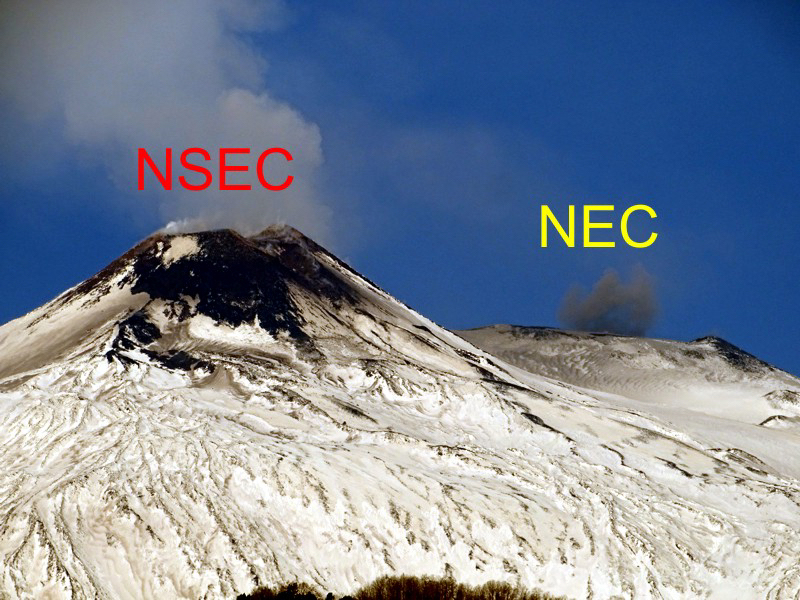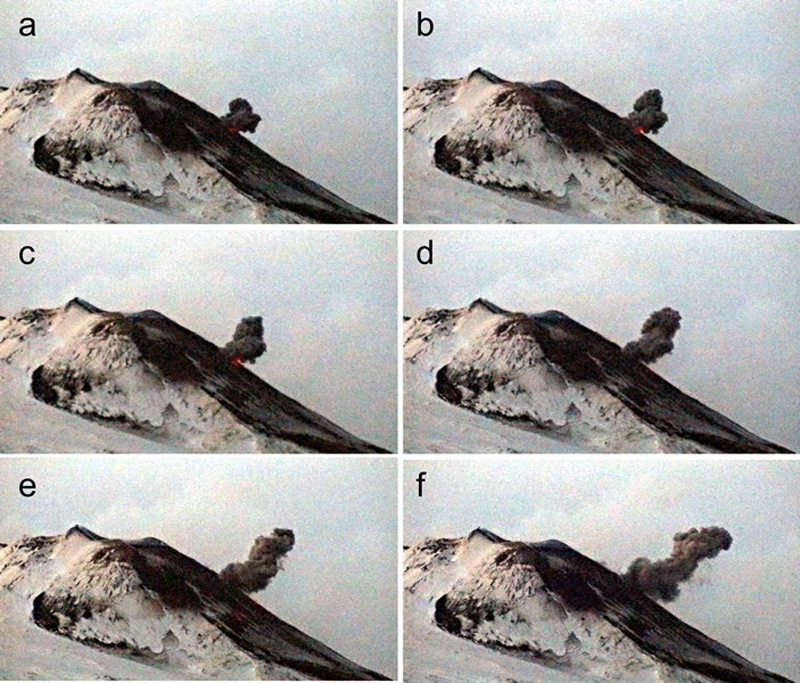Report on Etna (Italy) — April 2018
Bulletin of the Global Volcanism Network, vol. 43, no. 4 (April 2018)
Managing Editor: Edward Venzke.
Edited by A. Elizabeth Crafford.
Etna (Italy) Persistent degassing from multiple vents; minor ash emissions and pyroclastic ejecta, September 2017-March 2018
Please cite this report as:
Global Volcanism Program, 2018. Report on Etna (Italy) (Crafford, A.E., and Venzke, E., eds.). Bulletin of the Global Volcanism Network, 43:4. Smithsonian Institution. https://doi.org/10.5479/si.GVP.BGVN201804-211060
Etna
Italy
37.748°N, 14.999°E; summit elev. 3357 m
All times are local (unless otherwise noted)
Italy's Mount Etna on the island of Sicily has had historically recorded eruptions for the past 3,500 years and has been erupting continuously since September 2013 through at least March 2018. Lava flows, explosive eruptions with ash plumes, and lava fountains commonly occur from its major summit crater areas that include the North East Crater (NEC), the Voragine-Bocca Nuova (or Central) complex (VOR-BN), the South East Crater (SEC) (formed in 1978), and the New South East Crater (NSEC) (formed in 2011). A new crater, referred to as the "Cono della sella" or CdS, emerged during early 2017 in the saddle between SEC and NSEC (figure 206).
The most recent eruptive episode began with ash emissions from a new vent in the saddle between NSEC and SEC on 20 January 2017, followed by Strombolian activity a few days later (BGVN 42:10). Activity intensified at the end of February when the first of several lava flows emerged from this and other adjacent vents. By mid-March 2017, Strombolian activity, ash emissions, and lava flows had created a cone higher than the adjacent NSEC and SEC cones, referred to as the "Cono della Sella" (CdS) or saddle cone. An effusive episode at the end of April 2017 sent flows down both the N and S flanks of the new cone from multiple vents. Intermittent Strombolian activity and persistent fumarolic activity continued from multiple crater areas, and minor ash emissions were observed a few times through August 2017. The Osservatorio Etneo (OE), which provides weekly reports and special updates on activity, is run by the Catania Branch of Italy's Istituo Nazionale di Geofisica e Vulcanologica (INGV). This report uses information from INGV to summarize events between September 2017 and March 2018.
Although still exhibiting intermittent volcanism, activity at Etna was at low levels during September 2017-March 2018. A comparison of the thermal activity of that period with the previous interval of November 2016-August 2017 (figure 186, BGVN 42:10) demonstrates the order of magnitude decrease from the earlier period (figure 207). Persistent degassing occurred throughout this interval, often with incandescent gas and periodic ash emissions resulting from continued subsidence around crater vents and from small explosive events. Ashfall was reported once in the cities S of Etna in mid-January 2018, and a minor episode of Strombolian activity and ash emissions took place at the eastern vent of NSEC in mid-February 2018.
Activity during September-December 2017. Active degassing at the beginning of September 2017 occurred from the vent at the E rim of the Voragine crater (VOR), and from the NW vent of Bocca Nuova (BN-1) (figure 208). At the Northeast Crater (NEC) and the SE Crater (SEC)-New South East Crater (NSEC) complex, which included the new "Cono del Sella" (CdS), there was widespread degassing from the fumarolic fields located in the bottoms and walls of the craters. Minor explosive activity was reported on 19 September 2017 from BN and NSEC, and nighttime incandescence was reported from the other craters. On 20 September small sporadic ash emissions were noted from NSEC and VOR. Incandescence at night was observed at the SEC-NSEC complex for the remainder of the month, and strong degassing continued at the VOR vent.
Occasional ash emissions were observed during the second week of October 2017 from the Cono della Sella (CdS) (figure 209). A minor ash emission was also reported on 16 October from the SEC-NSEC complex. Minor emissions of brown ash were reported from BN-1 during the last week of October. In the late afternoon of 26 October, a single explosion occurred at one of the three mouths of the Cono della Sella crater. The explosion generated a short jet of incandescent material and a small ash plume that quickly dispersed.
Cloudy weather during November resulted in limited visibility for much of the month. A small, isolated explosion containing minor ash occurred at SEC on 14 November 2017. During the third week of November, a new pit crater appeared at the bottom of NEC that measured 70 x 50 m (figure 210), and intense degassing was observed from BN-1. Frequent small ash emissions were reported from CdS during 24-26 November. In the last week of the month, pulsating degassing from the craters could be detected during periods of limited visibility, as well as a series of explosions with ash emissions from SEC.
Degassing from the summit craters persisted throughout December 2017 with intermittent incandescence observed from fumaroles at NSEC. A few ash emissions were recorded from CdS, including overnight on 14-15 December (figure 211).
Activity during January-March 2018. Similar activity continued throughout January 2018; a small ash emission was observed from CdS on 5 January, and a puff of brown ash emerged from NSEC the next day. Incandescence degassing also continued from the NSEC vents. During the second week of the month, 20 small explosive events were observed from the eastern vent at NSEC, although cloud cover obscured the summit for much of the time. Minor ash emissions continued from NSEC for the rest of the month, along with nighttime incandescence, especially strong from BN-1. On 22 January a modest ashfall affected the communities S of Etna including the city of Catania (27 km S); the lack of visibility prevented identification of which crater produced the ash. By the end of the month, the pit crater at the base of NEC had expanded, causing erosion of the inner E wall (figure 212). In spite of the low level of activity during this period, SO2 emissions were occasionally recorded with satellite instruments. The most significant SO2 plumes were measured during the last few days of January (figure 213).
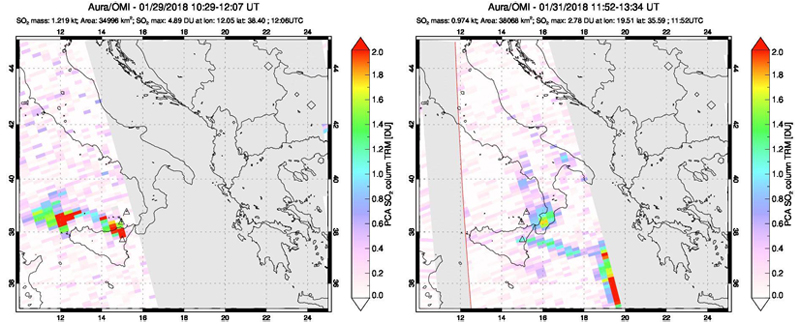 |
Figure 213. Significant SO2 plumes were measured from Etna on 29 (left) and 31 (right) January 2018 by the OMI instrument on NASA's Aura satellite. Courtesy of NASA Goddard Space Flight Center. |
Two weak ash emissions occurred at NSEC during the first week of February 2018. The frequency of explosions increased during 15-16 February to 1-2 events per hour, producing moderate amounts of brown-gray ash and incandescent pyroclastic material (figure 214); heightened activity lasted for several days. The explosions were heard 20 km E and S from the summit. Faint, non-explosive emissions of gray ash were observed on the morning of 17 February 2018 from NEC (figure 215).
Degassing continued at the summit craters for the remainder of February and throughout March 2018. During an inspection by INGV on 10 March, the expansion of the pit crater at the bottom of NEC was noted, as was continuing collapses of the internal walls which produced minor ash emissions. Activity at the E vent of NSEC included a minor ash emission on 2 March 2018; occasional ejection of incandescent pyroclastic material and modest ash emissions continued throughout the month (figure 216). The ash emissions occurred at irregular intervals, varying from a few tens of minutes to a few hours, more frequently in the last days of the month.
Geological Summary. Mount Etna, towering above Catania on the island of Sicily, has one of the world's longest documented records of volcanism, dating back to 1500 BCE. Historical lava flows of basaltic composition cover much of the surface of this massive volcano, whose edifice is the highest and most voluminous in Italy. The Mongibello stratovolcano, truncated by several small calderas, was constructed during the late Pleistocene and Holocene over an older shield volcano. The most prominent morphological feature of Etna is the Valle del Bove, a 5 x 10 km caldera open to the east. Two styles of eruptive activity typically occur, sometimes simultaneously. Persistent explosive eruptions, sometimes with minor lava emissions, take place from one or more summit craters. Flank vents, typically with higher effusion rates, are less frequently active and originate from fissures that open progressively downward from near the summit (usually accompanied by Strombolian eruptions at the upper end). Cinder cones are commonly constructed over the vents of lower-flank lava flows. Lava flows extend to the foot of the volcano on all sides and have reached the sea over a broad area on the SE flank.
Information Contacts: Sezione di Catania - Osservatorio Etneo, Istituto Nazionale di Geofisica e Vulcanologia (INGV), Sezione di Catania, Piazza Roma 2, 95123 Catania, Italy (URL: http://www.ct.ingv.it/it/ ); MIROVA (Middle InfraRed Observation of Volcanic Activity), a collaborative project between the Universities of Turin and Florence (Italy) supported by the Centre for Volcanic Risk of the Italian Civil Protection Department (URL: http://www.mirovaweb.it/); NASA Goddard Space Flight Center (NASA/GSFC), Global Sulfur Dioxide Monitoring Page, Atmospheric Chemistry and Dynamics Laboratory, 8800 Greenbelt Road, Goddard, Maryland, USA (URL: https://so2.gsfc.nasa.gov/).


